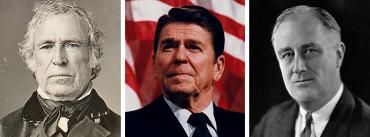
In the final days of the presidential election, Florida, once again, dominates the national spotlight. Donald Trump needs to carry the Sunshine State to beat Hillary Clinton which is why the campaigns are dispatching the candidates and their top surrogates to Florida as the clock ticks down to election day. Polls show a close contest with, as of Friday morning, Republicans clinging to an early lead in early voting.
Florida has been the most important swing state in recent presidential elections but it had a far more minor role throughout most of American history. After becoming a state in 1845, Florida first went way for Whig candidate Zachary Taylor in 1848. Taylor had a built a good reputation with Florida residents during his time in command of American forces in the Second Seminole War. A planter from Louisiana and a military hero, Taylor was a good fit for Florida voters, even if politicians from the state--namely David Levy Yulee--ended up clashing with him in the heated debates leading up to the Compromise of 1850.
After backing Taylor, Florida switched over to the Democrats. Winfield Scott also commanded Army forces in Florida in the Second Seminole War but voters here didn’t care for the stuffy “Old Fuss and Feathers” when he ran as the Whig presidential candidate in 1852. Franklin Pierce carried Florida in 1852 and James Buchanan had no problem keeping it in the Democratic column four years later.
With the Democrats splitting in 1860, Florida backed Buchanan’s Vice President John Breckinridge who was the candidate of the Southern Democrats against Republican Abraham Lincoln, Northern Democrat Stephen Douglas and Constitutional Unionist and Whig John Bell in that pivotal presidential election. After the Civil War, with Union troops occupying Florida during Reconstruction, the state backed Ulysses S. Grant in 1868 and 1872 before the heated and controversial 1876 election. Florida was a mess with the governor certifying that fellow Republican Rutherford B. Hayes carried the state while the attorney general and the incoming governor certified that Democrat Samuel J. Tilden won. Congress voted on the disputed electoral college votes, giving them all to Hayes, letting him beat Tilden by one electoral college vote, but Southern Democrats garnered a number of concessions, including ending Reconstruction.
After Reconstruction ended, Florida was a reliable member of the Solid South, throwing its support to Democratic candidates no matter who they were--conservatives like Grover Cleveland, populists like William Jennings Bryan, progressives like Woodrow Wilson. Admittedly, Florida’s small size and support for Democrats made it unimportant during the nineteenth and start of the twentieth centuries outside the 1876 election. Up until the 1872 election, Florida only had three electoral votes. That moved up to four in 1872, five in 1904 and six in 1912.
After decades as part of the Solid South, Florida went for the Republicans in 1928--helped in part to anti-Catholic Democrats like former Gov. Sidney Catts supporting GOP candidate Herbert Hoover over Democrat Al Smith, the first Catholic to win a major party’s presidential nomination. Four years later, FDR flipped Florida, which now had six electoral votes, back to the Democrats and it remained part of his coalition even as it moved up to eight electoral votes in 1944.
The state started growing by leaps and bounds in the middle of the 20th century thanks to a number of factors: World War Two, the space program, tourism, air conditioning, cost of living and doing business, the climate. As the population grew, so did the state’s political importance, especially as it shaped up as a political battleground.
Dwight Eisenhower flipped Florida back to the Republicans in 1952 as the state grew to have ten electoral votes. It remained in the Republican column as Ike beat Democrat Adlai Stevenson in their 1956 rematch and went for Richard Nixon over JFK in 1960. LBJ brought Florida, now with 14 electoral votes, back in the Democratic fold in 1964 before it went for Nixon again in 1968 and 1972 when it had 17 electoral votes. Jimmy Carter from neighboring Georgia carried Florida in 1976 before Ronald Reagan reeled it back in for the Republicans in 1980. Now with 21 electoral votes, Florida remained behind Reagan in 1984 and for his understudy George H.W. Bush in 1988. Now with 25 electoral votes, Florida stayed with Bush in 1992 but Bill Clinton carried it handily in 1996. Four years later, in the disputed 2000 election, George W. Bush won the White House with his narrow win over Al Gore in the Sunshine State.
Since the 2000 contest, Florida has only reinforced its role as the nation’s largest swing state. George W. Bush was assured a second term by beating John Kerry in Florida, now with 27 electoral college votes, in 2004. Barack Obama carried the state four years later and shut the door on Mitt Romney’s presidential ambitions by carrying it again in 2012 when it moved up to 29 electoral votes.
Florida is tied with New York with the third most electoral votes. But Florida is the largest state that’s up for grabs in a presidential election. California--and its 55 electoral votes--have been reliably Democratic since Bill Clinton flipped the state from George H.W. Bush in 1992. With its 38 electoral votes, Texas is reliably Republican. New York might go for a Republican on occasion--Nixon in 1972, Reagan in 1980 and 1984--but it’s solidly Democratic.
With Election Day looming on Tuesday, Trump needs to carry Florida. There’s simply no road to the White House without carrying the Sunshine State. Hillary Clinton can win the presidency without Florida but her chances increase dramatically if she nails down the state.


